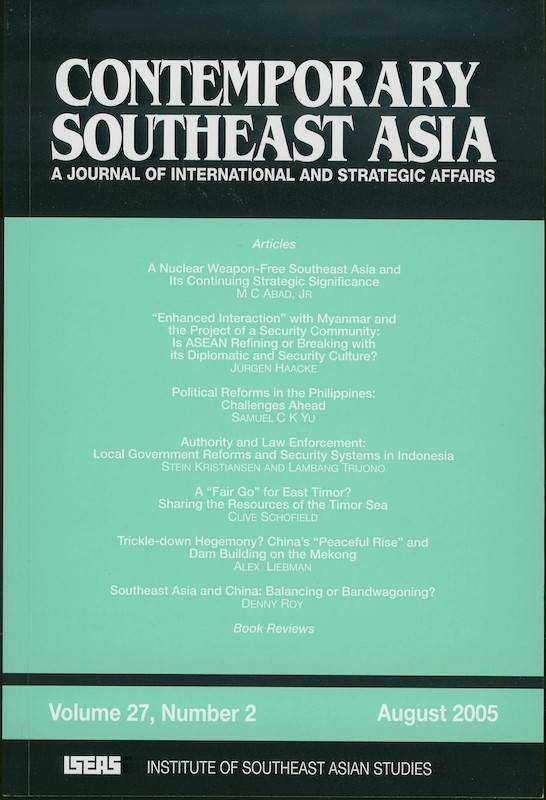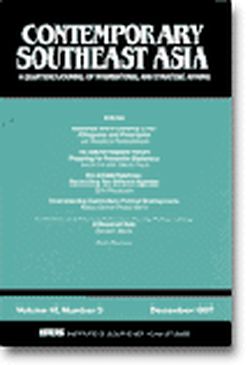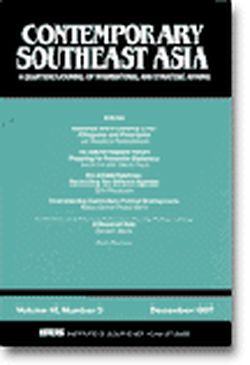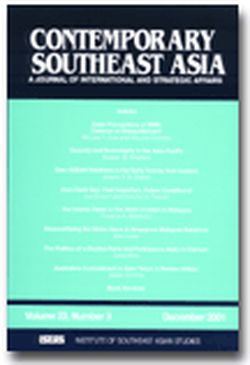Contemporary Southeast Asia: A Journal of International and Strategic Affairs Vol. 26/3 (Dec 2004)
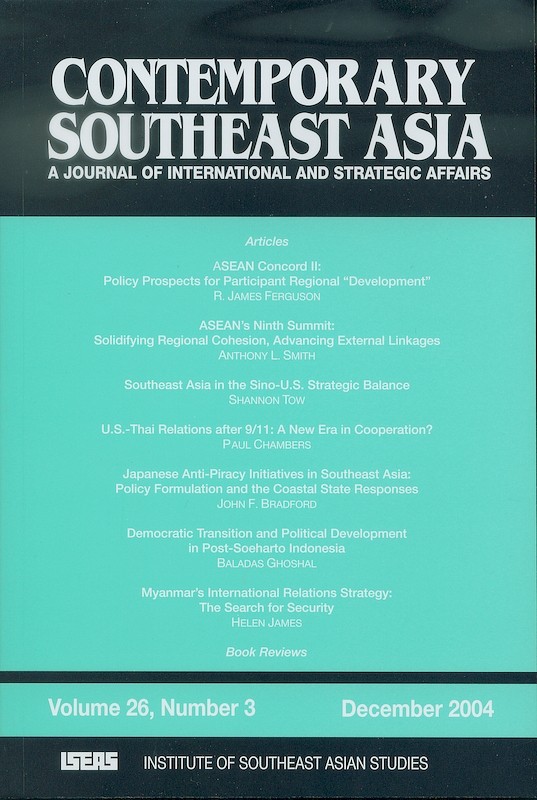
Date of publication:
December 2004
Number of pages:
179
Code:
CS26/3
Contents
-
Preliminary pages
- ARTICLES
-
ASEAN Concord II: Policy Prospects for Participant Regional Development, by R. James Ferguson, author see abstractWith a new ASEAN Concord II agreed to in late 2003, Southeast Asia has charted an ambitious path towards creating an ASEAN Community founded on economic, security and sociocultural pillars. The ASEAN agenda remains highly voluntary, with very limited supranational and institution aspects, though there has been some progress in shaping an ASEAN Economic Community (AEC) agenda, in part driven by strong Singaporean and Thai interests. This apparent policy gap can be viewed as a strategic ambiguity that will allow diverse member states to engage in the Community at their own level of capability, either via a two-tier approach of differential integration or via a notion of creative exemption.
-
ASEAN's Ninth Summit: Solidifying Regional Cohesion, Advancing External Linkages, by Anthony L Smith, author see abstractThe Association of Southeast Asian Nations (ASEAN) held its Ninth Summit in October 2003. The Summit, held in Bali, was notable for its announcement of an ASEAN Community, or Bali Concord II, which is to establish a security community, an economic community and a social community. These agreements are largely statements of intent, while the fleshing out of policy detail will have to occur at a later date. An Indonesian proposal to establish an ASEAN peacekeeping force, as part of the security community, has not been welcomed in all quarters. But despite the media coverage of ASEAN's Bali Concord II, the Bali Summit was particularly notable for the external linkages that ASEAN further solidified. The leaders of China, India, Japan and South Korea were all in attendance, and China and India acceded to ASEAN's Treaty of Amity and Cooperation during the Summit. Clearly all four Asian powers are increasingly vying for Southeast Asia's attention
-
Southeast Asia in the Sino-U.S. Strategic Balance, by Shannon Tow, author see abstractIn his article The Geography of Peace, Robert Ross postulates a bipolar regional power balance has emerged in East Asia. This theory is premised on the assumption that smaller Asian states will seek to compensate for their own vulnerability by clearly aligning with either China or the United States. In the case of Southeast Asia, however, stable but competitive Sino-U.S. relations have provided ASEAN states with considerable strategic leverage. Although these states maintain a close relationship with their respective geo-politically dominant great power, this leverage allows them to maneuver between and to strengthen their autonomy vis-Ã-vis China and the United States. Closer examination of the 1998 addendum to the 1990 U.S.-Singapore Memorandum of Understanding, the 1999 U.S.-Philippines Visiting Forces Agreement and the 1999 Sino-Thai Plan of Action for the 21st Century demonstrates these trends.
-
U.S.-Thai Relations after 9/11: A New Era in Cooperation?, by Paul Chambers, author see abstractThree years ago, the United States and Thailand seemed headed for a more strained and distant relationship. U.S. policy-makers viewed Bangkok as increasingly insignificant while Thailand sought to move out of its traditional U.S. orbit and increasingly balance the influence of Washington with China, Europe, and the Muslim world. Yet, since 2001, the United States and Thailand have become extremely close. This article examines the U.S.-Thai relationship from the 1980s to the present day, particularly focusing on the post-9/11 era in light of the Bush administrations war on terrorism and growing linkages between Thailand and the United States. Ultimately, the article analyzes what has accounted for warmer ties, why some strains still remain, and whether U.S.-Thai relations have in fact returned to their previous 1980s intimacy.
-
Japanese Anti-Piracy Initiatives in Southeast Asia: Policy Formulation and the Coastal State Responses, by John Bradford, author see abstractAlthough Japan is generally hesitant to adopt aggressive positions in Asia's political affairs, especially in those activities involving the use of force, it has taken a leading role in eradicating maritime piracy. Japanese proposals envisioning active multinational cooperation met with little enthusiasm among the Southeast Asian states, but less ambitious bilateral approaches have enjoyed relative success. This article discusses the causes of the Japanese anti-piracy initiatives and the Singaporean, Indonesian, and Malaysian responses
-
Democratic Transition and Political Development in Post-Soeharto Indonesia, by Baladas Ghoshal, author see abstractThis article analyses the prospect for democracy in Indonesia and the challenges it may encounter. Religious, ethnic, regional and socioeconomic tensions that engulf Indonesia today are the result of authoritarian governance under Soeharto's new order and due to the lack of peoples involvement and participation in the development and political processes. Democratic governance alone can correct that anomaly. Indonesia's transition to democracy at the moment is messy. Indonesia also will have to pass through a tortuous path before it can have a reasonable success in its democratic transformation.
-
Myanmar's International Relations Strategy: The Search for Security, by Helen James, author see abstractIn 2006, Myanmar will chair ASEAN and the country's leadership will need to be in a position to show that real reform measures have been instituted. At the Bali summit, the Prime Ministers strategic discussions held with his counterparts from China, Japan, Korea and India, as well as the ASEAN governments, could set the scene for a new era of peaceful cooperation, trade and investment capable of providing Myanmar with the resources for implementation of the democratic governance urged on her by the international community. Myanmar's international relations strategy, focused within the Asian region, is designed to complement its domestic policies in pursuit of stability, unity and peaceful development. This article analyses Myanmar's new international relations agenda in the context of its domestic reform program and its overarching search for security.
- Book Reviews
-
Book Review: Southeast Asia over Three Generations: Essays Presented to Benedict R. OG Anderson Edited by James T. Siegel and Audrey R. Kahin, by Anthony Reid, author
-
Book Review: Southeast Asian Studies: Pacific Perspectives Edited by Anthony Reid, by Ooi Kee Beng, author
-
Book Review: Thaksin: The Business of Politics in Thailand By Pasuk Phongpaichit and Chris Baker, by Alex M Mutebi, author
-
Book Review: Researching Indonesia: A Guide to Political Analysis By Gerald L. Houseman, by Leonard C Sebastian, author
-
Book Review: Asia-Pacific Security Cooperation: National Interests and Regional Order Edited by See Seng Tan and Amitav Acharya, by Johan Saravanamuttu, author

